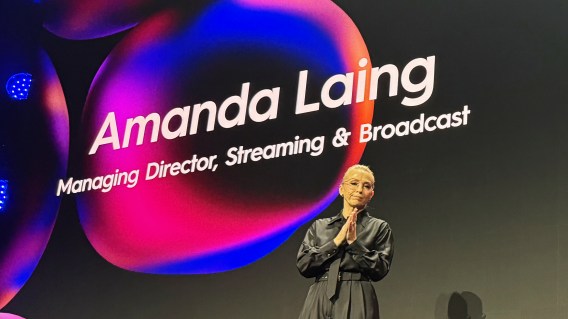Nine seeks to claim its ‘unfair advantage’
TrinityP3’s Stephen Wright continues his upfronts series for Mumbrella, today dissecting Nine’s attempt to differentiate itself from the pack through integration, partnership and emotional connection to the audience.

Amanda Laing at the Nine upfront (Mumbrella)
Well dear marketer, we are rounding the corner in the home stretch of this year’s upfronts season.
The tech players and streaming services have all made their claims. Now, yesterday afternoon we saw Nine — as Australia’s largest locally owned media company — deliver its response.
And I’m sure it was by design that the traditional networks are the only upfronts remaining.
Sun Tzu’s mantra”If you know the enemy and know yourself you need not fear the result of a hundred battles” was very much Nine’s mindset.
The theme and selling point of many of the upfronts to date has been the immediacy of retail opportunity, connection to sale and “purchase click”. For marketers this is straightforward functional delivery of the purchase opportunity.
This was never a territory that Nine could win and shrewdly they chose not to compete.
They set up their “unfair advantage” highlighting its high quality, unparalleled depth of connection in programming that is known and loved by Australians. “Others merely touch Australian culture, we define it” was one line, “Made by Australians for Australians” another.
It’s a message and theme that challenges many of today’s marketers and media planners.

The rapidly-filling Nine upfront venue at Carriageworks, Sydney
What delivers best: does a high quality of emotional connection work better as a trigger to sale than the capacity to quickly convert interest to purchase? And if I fail to offer an immediate purchase mechanic is the sale opportunity truly lost?
The reality is the answer to this dilemma will vary by product and category, but if it was only about proximity to point of purchase, advertising in supermarkets would dominate outdoor spending (note to reader: it doesn’t).
Changing the conversation and leaning into its strengths in content, culture and connection to Australian audiences is a smart play by Nine, and one that is of increasing relevance to media planners and clients as the AI conversation looms large.
AI raises the floor, not the ceiling, and provides every client in a category with a more comprehensive understanding of the media environments that are efficient and effective.
However as everyone gets clued in on what works another principle of media kicks in … meaningful cut-through and share of voice.
Finding clearer space and deeper engagement in different places will be where brands can amplify the delivery of their media dollars. This is why Nine, through its 9Powered division, put integration and partnerships front and centre with the tagline: “Fuelled by ambition, ignited by partnership”.
This isn’t new territory for 9Powered (as anyone who has ever watched The Block with its cornucopia of brands will know). They have long been leaders in this space with clever integrations on things like the Australia Open (think Uber Eats) and NRL (think Westpac Red Zone).
Whether brand leader or challenger, this is a territory to which every marketer should aspire.

The author Stephen Wright
The new tech players and streaming services in the TV space are far more rigid in what they can do and have far less opportunities. Nine do indeed have an unfair advantage in their capacity to deliver customised delivery woven into content extended and integrated across multiple platforms.
The word amplify appeared at one point in Nine’s deluge of messaging themes. It was largely around a new product, 9Amplify, which offers social extension through Nine’s “army” of talent (think Scott Cam or Sophie Monk plugging wares on Instagram). But true amplification is one they, as the biggest local player should champion, isolate and own within a landscape increasingly AI obsessed.
True amplification of media spend and marketing effect is a powerful and poignant message that carves out rich territory and lands a true “unfair advantage”.
On other matters … upfronts used to be all about the reel of new content, but as Nine’s TV/streaming boss Amanda Laing noted, buyers know the slate (think MAFS, The Block, Love Island, The Floor and one new show Shark – where celebs swim with sharks). Each year it feels like there are less and less content announcements in the upfronts.
Instead a player like Nine is increasingly seeking to compete on scale, reach and technology. The reality is Nine’s strength and advantage aren’t new shows, it’s the old favourites, the tried and tested, news and live sport.
This was an upfront with no talent on stage, but rather key execs front and centre. They were making a pitch which highlighted how they are different not just to Seven and Ten (their old competitors) but the new wave of tech and streaming competitors (YouTube, Amazon, Netflix and Meta).
Nine did find itself and carve out some territory, but the deluge of messages and competing themes left me wondering whether it fully understood the power of its opportunity and how to land it.
Stephen Wright is global media lead at TrinityP3.

